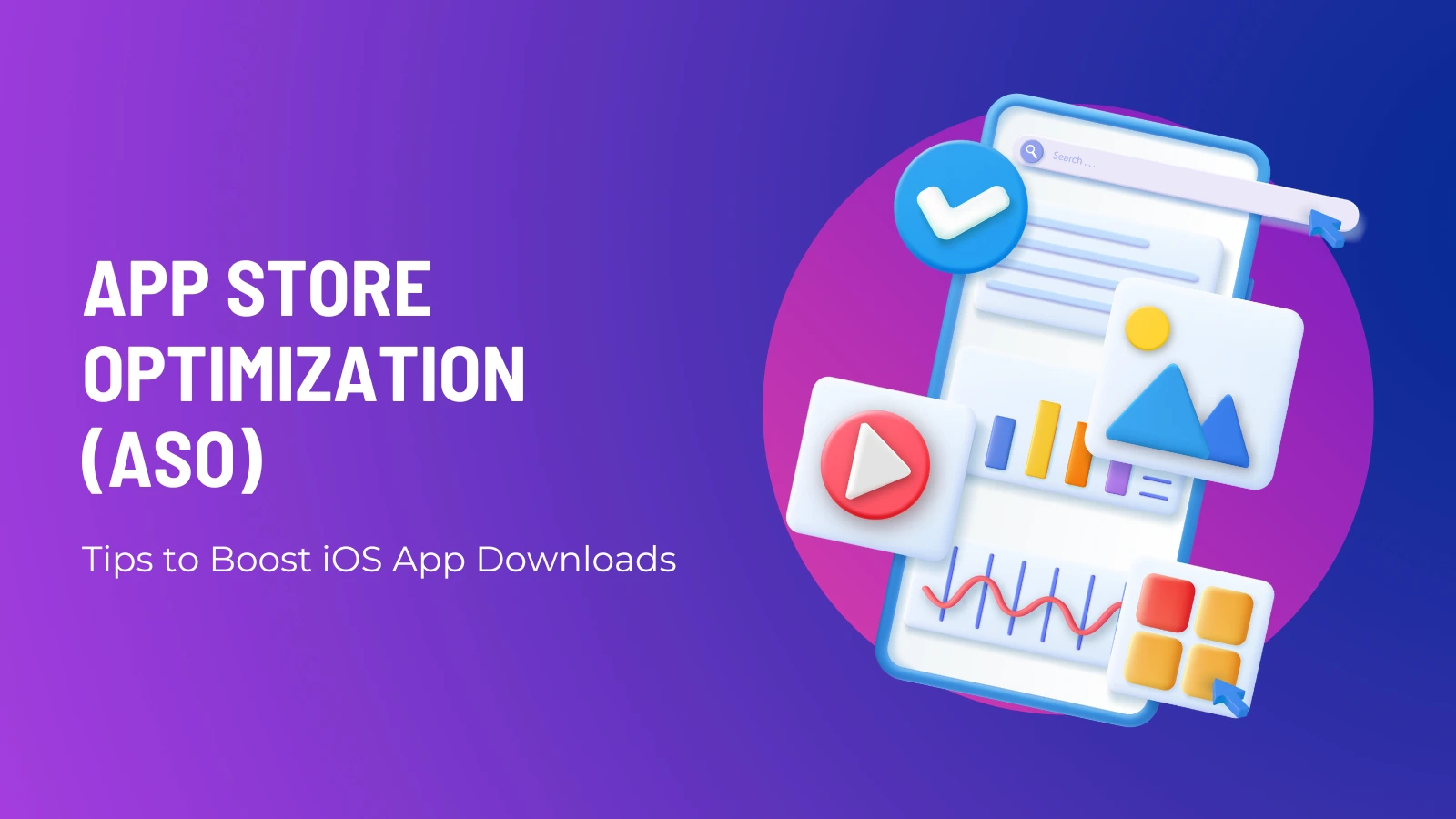App Store Optimization (ASO) Tips to Boost iOS & Android App Downloads
Understanding App Store Optimization (ASO): Why It Matters for iOS App Growth
Why does ASO matter?
There are millions of apps vying for users' attention in the cluttered App Store. Even the most useful and creative apps may go unnoticed without optimization. ASO drives organic downloads, which lowers acquisition costs and encourages recurring user retention. Improving your app's visibility in the App Store may make or break it, especially for iOS apps where competition is fierce due to higher income prospects.
App conversion rates are improved with ASO in addition to visibility. If an app listing includes compelling wording, eye-catching graphics, and pertinent keywords, it can convert a browser into a loyal user. For businesses that use mobile applications for customer support, brand engagement, or revenue generation, this might lead to tremendous commercial development. iOS app development companies must incorporate ASO tactics into the development cycle to guarantee that the product is prepared for the market upon release.
In essence, ASO is not a luxury add-on but a fundamental part of mobile strategy. If you're a new startup releasing your first app or a successful company venturing into mobile, a strong ASO foundation is crucial. It establishes the foundation for all further marketing and guarantees that you begin from a position of strength within the crowded iOS environment.
Keyword Optimization: The Backbone of Effective ASO Strategy
Keyword optimization is one of the cornerstones of App Store Optimization. It's how people discover your app, and oftentimes it's what makes your app be seen or stay hidden in the dark. For iOS app development firms, knowing how to study, select, and use keywords can make a big difference in the success of client projects.
Keyword optimization begins with finding those terms and phrases that your target market will query in searching for applications such as yours. Apple Search Ads, Sensor Tower, and App Annie can provide insights into those high-traffic keywords and trends in searches. Once found, those keywords should be utilized sensibly within your app title, subtitle, and keyword field. But don't forget, keyword stuffing is bad news; balance and relevance are more important.
App title weighs the most in Apple's search algorithm. Adding a main keyword here will get you rated high. For instance, if you're selling a fitness tracker app, adding something like "Workout Tracker" to the title will do the trick. Likewise, the subtitle should contain secondary keywords that complement the title and provide additional context.
Aside from metadata, keywords should further shape your app description, even though it's not indexed by Apple's algorithm. Yet, a keyword-heavy description can still aid in user understanding and conversion. It also increases visibility when your app listing is posted on external platforms or indexed by search engines.
To iOS application development firms, providing keyword research and optimization as an ancillary service can provide immeasurable value to customers. It's a fact-based practice that has a direct effect on performance metrics such as download numbers, retention, and revenue. As part of your ASO plan, continuously track keyword performance and update accordingly based on analytics. App Store trends change, and so should your keyword plan.
Visual Assets That Convert: App Icons, Screenshots, and Previews
With the visual-first environment of app stores, your app's visual appearance becomes a key determinant of user acquisition. App icons, screenshots, and video previews can be either going to win over a potential user or repel them. For any serious iOS app development firm interested in results, developing engaging visual assets needs to be a part of the app development and marketing process.
The app icon is your brand's first visual impression that the user will get. It must be minimalist, identifiable, and legible at varying sizes. Don't clutter it, and please, use bold contrasting colors so that it doesn't get lost. Consider the icon your app's logo—coherence with your brand identity is important.
Screenshots provide a chance to visually explain your app's essential features and benefits. Instead of taking generic screens, make use of annotated images accompanied by captions that point out key features and value propositions. Always start with your best screens—the first 2-3 screenshots are the most frequently viewed, so make them impressive.
Video previews (or App Previews within the Apple environment) are another strong weapon. A 15 to 30-second video showing your app in use has the ability to greatly increase conversion rates. Emphasize user experience, speed, and most important features. Make it simple yet informative, and always follow Apple's preview guidelines.
For iOS app development firms, adding visual asset creation to your ASO package can differentiate you. It's not only about coding; it's about providing a product that looks good, feels good, and works well in the App Store. Work with designers and marketers to make sure the visuals meet user and market standards. Professional visual assets can significantly enhance click-through rates and, eventually, downloads.
User Reviews and Ratings: Constructing Social Proof and Trust
User ratings and reviews are not simply measures of app quality—they are important ASO considerations that impact visibility and conversions. Positive reviews and good ratings serve as social proof, prompting potential users to download your app. For any iOS app development company, building strategies to gain and sustain positive reviews must be included in an end-to-end ASO strategy
The App Store algorithm takes into account your app's average rating, the quantity of reviews, and the rate at which the reviews are submitted. Ongoing streams of favorable reviews indicate relevance and user satisfaction, driving your app further up the search ranking. In contrast, a brief rating slump can drive visibility downward.
Ask satisfied users to leave a review by incorporating subtle ask within the app experience. For example, trigger a review ask after someone completes an action or reaches a milestone that is significant to them. Don't interrupt the user experience with obtrusive ask—timing and context matter.
Responding to reviews is also crucial. A well-thought-out response to a bad review can make a critic an advocate. It also indicates to potential users that you value feedback and are dedicated to making improvements. Apple enables developers to reply directly, and responding can enhance your app's reputation.
Review trends can also provide insights into bugs, feature requests, and user expectations. Share this information with your product and development teams to use in future updates. For iOS app development companies, this closed feedback loop not only enhances app quality but also client satisfaction.
Incentivizing reviews, tempting as it is, should be done with caution. Apple prohibits rewarding reviews, and breaking this rule could have your app flagged. Instead, give value and a smooth user experience that naturally elicits good feedback.
Localizing for Global Reach: Expanding Your Audience Through ASO
Apple’s App Store supports multiple languages, and users in different countries often search in their native tongue. If your app is only optimized in English, you’re missing out on a significant chunk of potential users. Localizing keywords, descriptions, screenshots, and even app previews can improve your discoverability and download rates in international markets.
But localization is more than translation. It entails cultural adaptation to comply with local norms, preferences, and trends. For instance, color symbolism is very different between cultures—red may represent danger in one locality but good luck in another. Adapting your app's imagery and messaging accordingly can enhance engagement and trust.
The advantages of localization are concrete. From industry research, localized apps experience as much as a 128% boost in downloads for each country added. That's a strong argument for investing in localized ASO.
For iOS app development businesses, providing localization as a service can be a selling point. It becomes an additional value-added service to your app development offering and enablesyour clients to access global markets. Use analytics to determine which countries are already demonstrating organic interest, and localize accordingly.
In summary, localization is not an extravagance—it's a growth plan. By offering your app to more people, you not only drive more downloads but also create a more inclusive and internationally competitive brand.
Mastering App Store Optimization for Android: Tested Strategies to Boost Downloads
ASO for Android is all about optimizing many of the aspects like app name, description, icon, screenshots, reviews, and keywords. Contrary to Apple's App Store, Google Play searches through the entire app description for keywords, which provides more freedom but also demands a strategy. It is not merely about bringing in the users but also making them believe that your app is worth installing and retaining.
Secondly, the Google Play algorithm prefers more engaging, retained, and positively rated apps. Accordingly, ASO is not a one-time task; it needs constant observation, maintenance, and testing. A professional android app development company must look at ASO as a part of the larger app life cycle, starting from app development to user acquisition and scaling.
When executed properly, ASO can slash your cost of acquiring customers while boosting lifetime value. It strengthens natural growth so that you can grow a sustainable base of users without dependence on paid advertising. The good news? ASO runs automatically, delivering results days, weeks, and even months after deployment.
Keyword Optimization: Unlocking Organic Visibility in Google Play
Start by identifying high-volume, pertinent keywords that fit the purpose and target market of your app. To learn what people are searching for, use apps like App Annie, semrush, and Google Keyword Planner. The app title, short description, and long description must then contain these keywords in the appropriate places.
The title must contain the main keyword and be short enough at 30 characters for easier reading and indexing. The short description, being within 80 characters, must accentuate the app's major features and have at least one major keyword. The long description has more space—up to 4,000 characters—to organically fit in keywords while giving useful information about your app.
Avoid keyword stuffing, as it can lead to penalties and turn users away. Instead, focus on keyword density, relevance, and contextual usage. Update keywords periodically based on performance metrics and user behavior data.
An android app development firm providing ASO services can provide significant value by maintaining this continuous process, keeping their client's apps competitive and in the spotlight in a constantly changing marketplace. Keyword optimization is not a set-it-and-forget-it process—it's an active component of your app's marketing machine.
Visual Assets That Drive Installs: Design for First Impressions
The icon of your app is your brand on the store. It must be nice, clean, and in line with the overall design of the app. Bold colors, clean elements, and familiar symbols tend to work well. Refrain from text and elaborate designs that are difficult to read on small screens.
Screenshots must tell a story. Emphasize the app's key features and user interface through clean, high-res pictures. Use captions or annotations to indicate what each screenshot signifies, highlighting the app's value, not merely functionalities. Keep in mind that the first two to three screenshots are the most seen—make them memorable.
Feature graphics, while not required, are shown prominently in the app listing and with promotions. They should support your app's intended purpose and brand. A feature graphic designed well will enhance click-through ratio considerably.
Video previews also provide an opportunity to illustrate app usage live. A 30-second promotional video highlighting key features and use scenarios can be the make-or-break for most users. Keep it professional, concise, and according to Google Play's guidelines.
Finally, visual content closes the gap between discovery and download. An Android app development firm should work closely with UI/UX designers and marketers to make sure that visuals resonate with user expectations and enhance the attractiveness of the app.
User Ratings and Reviews: Building Trust and Community Engagement
Google Play puts a lot of importance on user content. Apps with regular, good reviews are likely to be suggested by the algorithm. In addition to that, users are likely to download apps that have a good review profile. Hence, it's important to engage active promotion of satisfied customers to post reviews while neutralizing negative feedback responsibly.
Timing makes everything. Encourage users to write reviews after a good experience—after the accomplishment of a task, a milestone, or a certain period of time spent in the app. Keep it simple and unobtrusive. Spammy strategies and incentivized reviews are both against Google policy and likely to backfire.
Engaging with reviews indicates that user feedback is important to you. It can turn a negative experience positive and indicates to potential users that your app is being actively maintained. Track the trends of feedback to locate bugs, feature requests, or usability problems. Future updates can be driven from this information and improve overall user satisfaction.
For android app development companies, managing this aspect of ASO means going beyond code. It’s about fostering a community around the app, building trust, and encouraging user loyalty. Regularly refreshing the app based on user insights also contributes to higher engagement and better retention.
In summary, good ratings and reviews are a strong ASO feature that can promote your app's visibility and appeal. They are public evidence of quality, stability, and customer satisfaction—crucial factors for any successful Android app.
Subscribe Now
Get the weekly updates on the newest brand stories, business models and technology right in your inbox.
More Blogs
The Essential Guide to Automation AI: What Actually Works in 2025
AI Automation has demonstrably reshaped the workings of businesses by processing data and completing repetitive tasks faster and more efficiently than human workers. To illustrate, AI systems can now examine vast amounts of data, simul...
AR vs VR in Automotive_ From Virtual Test Drives to AR Dashboards
The automotive industry has experienced transformative changes in the recent years, all thanks to breakthroughs in immersive technology. The most notable changes are due to Augmented Reality (AR) and Virtual Reality (VR). The debate of...
How AI is Powering the Future of Robotaxis & Machine Learning Algorithms Behind Autonomous Driving Systems
Robotaxis are fast becoming a science fiction dream turned reality, revolutionizing the way individuals move around cities. Robotaxis—autonomous vehicles that can transport people without the need for drivers—is revolutioni...

 Awards & Recognition
Awards & Recognition








